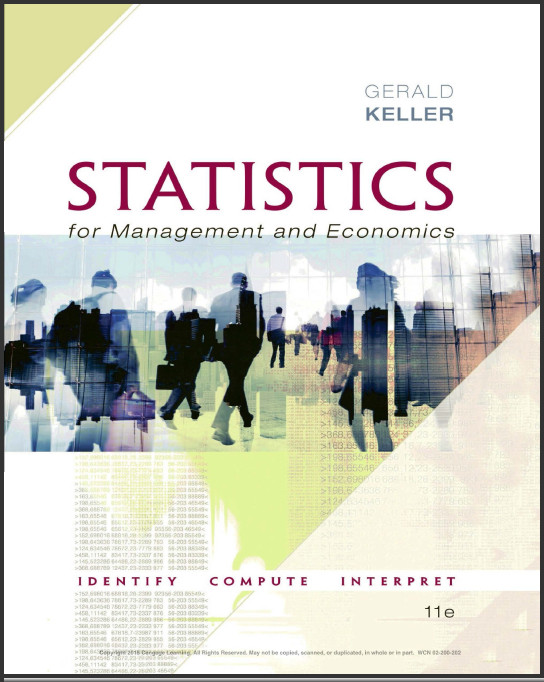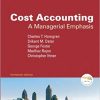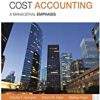Test Bank for Statistics for Management and Economics 11th Edition by Gerald Keller 1337093459 978-1337093453
$70.00 Original price was: $70.00.$35.00Current price is: $35.00.
Instant download (Test Bank) Statistics for Management and Economics 11th Edition by Keller after payment
Test Bank for Statistics for Management and Economics 11th Edition by Gerald Keller – Ebook PDF Instand Download/DeliveryISBN:
Full dowload Statistics for Management and Economics 11th Edition after payment

Product details:
ISBN-10 : 1337093459
ISBN-13 : 978-1337093453
Author: Gerald Keller
Discover how statistical methods and tools are vital for today’s managers as you learn how to apply these tools to real business problems. STATISTICS FOR MANAGEMENT AND ECONOMICS, 11E emphasizes applications over calculation using a proven three-step “ICI” approach to problem solving. You learn how to IDENTIFY the correct statistical technique by focusing on the problem objective and data type; how to COMPUTE the statistics by hand or using Excel or XLSTAT; and how to INTERPRET results in the context of the problem. Extensive data-driven examples, exercises, and cases address the functional areas of business and demonstrate how marketing managers, financial analysts, accountants, and economists rely on statistical applications. Engaging cases focus on climate change and the relationship between payroll and wins in professional sports, while dozens of exercises feature the returns on 40 stocks, which are used to develop the market model and portfolio diversification.
Statistics for Management and Economics 11th Table of contents:
1. What Is Statistics?
1-1. Key Statistical Concepts
1-1a. Population
1-1b. Sample
1-1c. Statistical Inference
1-2. Statistical Applications in Business
1-2a. Application Sections and Subsections
1-2b. Application Boxes
1-3. Large Real Data Sets
1-3a. General Social Survey
1-3b. Survey of Consumer Finances
1-4. Statistics and the Computer
1-4a. Excel
1-4b. Data Analysis Plus
1-4c. Minitab
1-4d. File names and Notation
1-4e. Our Approach
1-4f. Excel Spreadsheets
Chapter Summary
Chapter Exercises
Appendix 1. Material to Download
2. Graphical Descriptive Techniques I
2-1. Types of Data and Information
2-1a. Calculations for Types of Data
2-1b. Hierarchy of Data
2-1c. Interval, Ordinal, and Nominal Variables
2-1d. Problem Objectives and Information
2-2. Describing a Set of Nominal Data
2-2a. Other Applications of Pie Charts and Bar Charts
2-2b. Describing Ordinal Data
2-3. Describing the Relationship between Two Nominal Variables and Comparing Two or More Nominal Data Sets
2-3a. Tabular Method of Describing the Relationship between Two Nominal Variables
2-3b. Comparing Two or More Sets of Nominal Data
2-3c. Data Formats
Chapter Summary
Chapter Exercises
3. Graphical Descriptive Techniques II
3-1. Graphical Techniques to Describe a Set of Interval Data
3-1a. Determining the Number of Class Intervals
3-1b. Shapes of Histograms
3-2. Describing Time-Series Data
3-2a. Line Chart
3-3. Describing the Relationship between Two Interval Variables
3-3a. Patterns of Scatter Diagrams
3-3b. Linearity
3-3c. Direction
3-3d. Interpreting a Strong Linear Relationship
3-4. Art and Science of Graphical Presentations
3-4a. Graphical Excellence
3-4b. Graphical Deception
Chapter Summary
Chapter Exercises
4. Numerical Descriptive Techniques
4-1. Measures of Central Location
4-1a. Arithmetic Mean
4-1b. Median
4-1c. Mode
4-1d. Mean, Median, Mode: Which Is Best?
4-1e. Measures of Central Location for Ordinal and Nominal Data
4-2. Measures of Variability
4-2a. Range
4-2b. Variance
4-2c. Interpreting the Variance
4-2d. Standard Deviation
4-2e. Coefficient of Variation
4-2f. Measures of Variability for Ordinal and Nominal Data
4-2g. Approximating the Mean and Variance from Grouped Data
4-3. Measures of Relative Standing
4-3a. Locating Percentiles
4-3b. Interquartile Range
4-3c. Measures of Relative Standing and Variability for Ordinal Data
4-4. Measures of Linear Relationship
4-4a. Covariance
4-4b. Coefficient of Correlation
4-4c. Comparing the Scatter Diagram, Covariance, and Coefficient of Correlation
4-4d. Least Squares Method
4-4e. Coefficient of Determination
4-4f. Interpreting Correlation
4-5. (Optional) Applications in Finance: Market Model
4-5a. Systematic and Firm-Specific Risk
4-6. Comparing Graphical and Numerical Techniques
4-7. General Guidelines for Exploring Data
Chapter Summary
Chapter Exercises
Appendix 4. Review of Descriptive Techniques
5. Data Collection and Sampling
5-1. Methods of Collecting Data
5-1a. Direct Observation
5-1b. Experiments
5-1c. Surveys
5-2. Sampling
5-3. Sampling Plans
5-3a. Simple Random Sampling
5-3b. Stratified Random Sampling
5-3c. Cluster Sampling
5-3d. Sample Size
5-4. Sampling and Nonsampling Errors
5-4a. Sampling Error
5-4b. Nonsampling Error
Chapter Summary
6. Probability
6-1. Assigning Probability to Events
6-1a. Three Approaches to Assigning Probabilities
6-1b. Defining Events
6-1c. Probability of Events
6-1d. Interpreting Probability
6-2. Joint, Marginal, and Conditional Probability
6-2a. Intersection
6-2b. Marginal Probability
6-2c. Conditional Probability
6-2d. Independence
6-2e. Union
6-3. Probability Rules and Trees
6-3a. Complement Rule
6-3b. Multiplication Rule
6-3c. Addition Rule
6-3d. Probability Trees
6-4. Bayes’s Law
6-4a. Bayes’s Law Formula (Optional)
6-4b. Applications in Medicine and Medical Insurance (Optional)
6-4c. Developing an Understanding of Probability Concepts
6-5. Identifying the Correct Method
6-5a. Joint Probabilities Are Given
6-5b. Joint Probabilities Are Required
Chapter Summary
Chapter Exercises
7. Random Variables and Discrete Probability Distributions
7-1. Random Variables and Probability Distributions
7-1a. Discrete Probability Distributions
7-1b. Probability Distributions and Populations
7-1c. Describing the Population/Probability Distribution
7-1d. Laws of Expected Value and Variance
7-2. Bivariate Distributions
7-2a. Marginal Probabilities
7-2b. Describing the Bivariate Distribution
7-2c. Sum of Two Variables
7-3. (Optional) Applications in Finance: Portfolio Diversification and Asset Allocation
7-3a. Portfolio Diversification in Practice
7-3b. Portfolios with More Than Two Stocks
7-4. Binomial Distribution
7-4a. Binomial Random Variable
7-4b. Cumulative Probability
7-4c. Binomial Table
7-4d. Mean and Variance of a Binomial Distribution
7-5. Poisson Distribution
7-5a. Poisson Table
Chapter Summary
Chapter Exercises
8. Continuous Probability Distributions
8-1. Probability Density Functions
8-1a. Uniform Distribution
8-1b. Using a Continuous Distribution to Approximate a Discrete Distribution
8-2. Normal Distribution
8-2a. Calculating Normal Probabilities
8-2b. Finding Values of Z
8-2c. Z A and Percentiles
8-3. (Optional) Exponential Distribution
8-4. Other Continuous Distributions
8-4a. Student t Distribution
8-4b. F Distribution
Chapter Summary
9. Sampling Distributions
9-1. Sampling Distribution of the Mean
9-1a. Sampling Distribution of the Mean of Two Dice
9-1b. Creating the Sampling Distribution Empirically
9-1c. Using the Sampling Distribution for Inference
9-1d. Creating the Sampling Distribution Empirically by Computer Simulation
9-2. Sampling Distribution of a Proportion
9-2a. (Optional) Normal Approximation to the Binomial Distribution
9-2b. Omitting the Correction Factor for Continuity
9-2c. Approximate Sampling Distribution of a Sample Proportion
9-3. Sampling Distribution of the Difference between Two Means
9-4. From Here to Inference
Chapter Summary
10. Introduction to Estimation
10-1. Concepts of Estimation
10-1a. Point and Interval Estimators
10-1b. Developing an Understanding of Statistical Concepts
10-2. Estimating the Population Mean When the Population Standard Deviation Is Known
10-2a. Interpreting the Confidence Interval Estimate
10-2b. Information and the Width of the Interval
10-2c. (Optional) Estimating the Population Mean Using the Sample Median
10-3. Selecting the Sample Size
10-3a. Error of Estimation
10-3b. Determining the Sample Size
Chapter Summary
11. Introduction to Hypothesis Testing
11-1. Concepts of Hypothesis Testing
11-2. Testing the Population Mean When the Population Standard Deviation Is Known
11-2a. Rejection Region
11-2b. Standardized Test Statistic
11-2c. p-Value
11-2d. Interpreting the p-Value
11-2e. Describing the p-Value
11-2f. The p-Value and Rejection Region Methods
11-2g. Solving Manually, Using Excel, and Using XLSTAT
11-2h. Interpreting the Results of a Test
11-2i. One- and Two-Tail Tests
11-2j. When Do We Conduct One- and Two-Tail Tests?
11-2k. Testing Hypotheses and Confidence Interval Estimators
11-2l. Developing an Understanding of Statistical Concepts 1
11-2m. Developing an Understanding of Statistical Concepts 2
11-3. Calculating the Probability of a Type II Error
11-3a. Effect on β of Changing α
11-3b. Judging the Test
11-3c. Developing an Understanding of Statistical Concepts: Larger Sample Size Equals More Information Equals Better Decisions
11-3d. Power of a Test
11-3e. Operating Characteristic Curve
11-3f. Determining the Alternative Hypothesis to Define Type I and Type II Errors
11-4. The Road Ahead
11-4a. Problem Objectives
11-4b. Derivations
Chapter Summary
12. Inference About a Population
12-1. Inference about a Population Mean When the Standard Deviation Is Unknown
12-1a. Checking the Required Conditions
12-1b. Estimating the Totals of Finite Populations
12-1c. Developing an Understanding of Statistical Concepts 1
12-1d. Developing an Understanding of Statistical Concepts 2
12-1e. Developing an Understanding of Statistical Concepts 3
12-2. Inference about a Population Variance
12-2a. Statistic and Sampling Distribution
12-2b. Testing and Estimating a Population Variance
12-2c. Checking the Required Condition
12-3. Inference about a Population Proportion
12-3a. Parameter
12-3b. Statistic and Sampling Distribution
12-3c. Testing and Estimating a Proportion
12-3d. Missing Data
12-3e. Estimating the Total Number of Successes in a Large Finite Population
12-3f. Selecting the Sample Size to Estimate the Proportion
12-3g. Wilson Estimators (Optional)
12-4. (Optional) Applications in Marketing: Market Segmentation
Chapter Summary
Chapter Exercises
13. Inference about Comparing Two Populations
13-1. Inference about the Difference between Two Means: Independent Samples
13-1a. Decision Rule: Equal-Variances or Unequal-Variances t-Tests and Estimators
13-1b. Checking the Required Condition
13-1c. Violation of the Required Condition
13-1d. Data Formats
13-1e. Developing an Understanding of Statistical Concepts 1
13-1f. Developing an Understanding of Statistical Concepts 2
13-2. Observational and Experimental Data
13-3. Inference about the Difference between Two Means: Matched Pairs Experiment
13-3a. Estimating the Mean Difference
13-3b. Independent Samples or Matched Pairs: Which Experimental Design Is Better?
13-3c. Observational and Experimental Data
13-3d. Checking the Required Condition
13-3e. Violation of Required Condition
13-3f. Developing an Understanding of Statistical Concepts 1
13-3g. Developing an Understanding of Statistical Concepts 2
13-4. Inference about the Ratio of Two Variances
13-4a. Parameter
13-4b. Statistic and Sampling Distribution
13-4c. Testing and Estimating a Ratio of Two Variances
13-5. Inference about the Difference between Two Population Proportions
13-5a. Parameter
13-5b. Statistic and Sampling Distribution
13-5c. Testing and Estimating the Difference between Two Proportions
Chapter Summary
Chapter Exercises
Appendix 13. Review of Chapters 12 and 13
14. Analysis of Variance
14-1. One-Way Analysis of Variance
14-1a. Checking the Required Conditions
14-1b. Violation of the Required Conditions
14-1c. Can We Use the t-Test of the Difference between Two Means Instead of the Analysis of Variance?
14-1d. Can We Use the Analysis of Variance Instead of the t-Test of μ 1 – μ 2 ?
14-1e. Relationship between the F-Statistic and the t-Statistic
14-1f. Developing an Understanding of Statistical Concepts
14-2. Multiple Comparisons
14-2a. Fisher’s Least Significant Difference Method
14-2b. Bonferroni Adjustment to LSD Method
14-2c. Tukey’s Multiple Comparison Method
14-2d. Which Multiple Comparison Method to Use
14-3. Analysis of Variance Experimental Designs
14-3a. Single-Factor and Multifactor Experimental Designs
14-3b. Independent Samples and Blocks
14-3c. Fixed and Random Effects
14-4. Randomized Block (Two-Way) Analysis of Variance
14-4a. Checking the Required Conditions
14-1b. Violation of the Required Conditions
14-4c. Criteria for Blocking
14-4d. Developing an Understanding of Statistical Concepts
14-5. Two-Factor Analysis of Variance
14-4a. How the Sums of Squares for Factors a and B and Interaction are Computed
14-5b. Test for Differences in Number of Jobs between Men and Women
14-5c. Test for Differences in Number of Jobs between Education Levels
14-5d. Test for Interaction between Factors A and B
14-5e. What Is Interaction?
14-5f. Conducting the Analysis of Variance for the Complete Factorial Experiment
14-5g. Developing an Understanding of Statistical Concepts
14-6. (Optional) Applications in Operations Management: Finding and Reducing Variation
14-6a. Taguchi Loss Function
14-6b. Design of Experiments and Taguchi Methods
Chapter Summary
Chapter Exercises
Appendix 14. Review of Chapters 12, 13, 14
15. Chi-Squared Tests
15-1. Chi-Squared Goodness-of-Fit Test
15-1a. Test Statistic
15-1b. Required Condition
15-2. Chi-Squared Test of a Contingency Table
15-2a. Graphical Technique
15-2b. Test Statistic
15-2c. Rejection Region and p-Value
15-2d. Rule of Five
15-2e. Data Formats
15-3. Summary of Tests on Nominal Data
15-3a. Developing an Understanding of Statistical Concepts
15-4. (Optional) Chi-Squared Test for Normality
15-4a. Class Intervals
15-4b. Interpreting the Results of a Chi-Squared Test for Normality
Chapter Summary
Chapter exercises
Appendix 15. Review of Chapters 12, 13, 14, 15
16. Simple Linear Regression and Correlation
16-1. Model
16-2. Estimating the Coefficients
16-3. Error Variable: Required Conditions
16-3a. Observational and Experimental Data
16-4. Assessing the Model
16-4a. Sum of Squares for Error
16-4b. Standard Error of Estimate
16-4c. Testing the Slope
16-4d. Estimator and Sampling Distribution
16-4e. One-Tail Tests
16-4f. Coefficient of Determination
16-4g. Other Parts of the Computer Printout
16-4h. Developing an Understanding of Statistical Concepts
16-4i. Cause-and-Effect Relationship
16-4j. Testing the Coefficient of Correlation
16-4k. Violation of the Required Condition
16-5. Using the Regression Equation
16-5a. Predicting the Particular Value of y for a Given x
16-5b. Estimating the Expected Value of y for a Given x
16-5c. Effect of the Given Value of x on the Intervals
16-6. Regression Diagnostics—I
16-6a. Residual Analysis
16-6b. Nonnormality
16-6c. Heteroscedasticity
16-6d. Nonindependence of the Error Variable
16-6e. Outliers
16-6f. Influential Observations
16-6g. Procedure for Regression Diagnostics
Chapter Summary
Chapter Exercises
Appendix 16. Review of Chapters 12, 13, 14, 15, 16
17. Multiple Regression
17-1. Model and Required Conditions
17-2. Estimating the Coefficients and Assessing the Model
17-2a. Step 1: Select the Independent Variables That You Believe May Be Related to the Dependent Variable
17-2b. Step 2: Use a Computer to Compute All the Coefficients and Other Statistics
17-2c. Step 3: Assess the Model
17-2d. Standard Error of Estimate
17-2e. Coefficient of Determination
17-2f. Testing the Validity of the Model
17-2g. Interpreting the Coefficients
17-2h. Testing the Coefficients
17-2i. A Cautionary Note about Interpreting the Results
17-2j. t-Tests and the Analysis of Variance
17-2k. The F-Test and the t-Test in the Simple Linear Regression Model
17-2l. Using the Regression Equation
17-3. Regression Diagnostics—II
17-3a. Multicollinearity
17-4. Regression Diagnostics—III (Time Series)
17-4a. Durbin–Watson Test
17-4b. Developing an Understanding of Statistical Concepts
Chapter Summary
Chapter Exercises
Appendix 17. Review of Chapters 12, 13, 14, 15, 16, 17
18. Model Building
18-1. Polynomial Models
18-1a. First-Order Model
18-1b. Second-Order Model
18-1c. Third-Order Model
18-1d. Polynomial Models with Two Predictor Variables
18-1e. First-Order Model
18-1f. First-Order Model with Two Predictor Variables and Interaction
18-1g. Second-Order Model with Interaction
18-2. Nominal Independent Variables
18-2a. Interpreting and Testing the Coefficients of Indicator Variables
18-3. (Optional) Applications in Human Resources Management: Pay Equity
18-3a. Regression Analysis for Equal-Pay-for-Work-of-Equal-Value Cases
18-4. (Optional) Stepwise Regression
18-4a. Stepwise Regression Procedure
18-5. Model Building
18-5a. Procedure for Building a Model
Chapter Summary
Chapter Exercises
19. Nonparametric Statistics
19-1. Wilcoxon Rank Sum Test
19-1a. Required Conditions
19-1b. Developing an Understanding of Statistical Concepts
19-2. Sign Test and Wilcoxon Signed Rank Sum Test
19-2a. Sign Test
19-2b. Test Statistic and Sampling Distribution
19-2c. Checking the Required Conditions
19-2d. Wilcoxon Signed Rank Sum Test
19-2e. Test Statistic and Sampling Distribution
19-3. Kruskal–Wallis Test and Friedman Test
19-3a. Hypotheses
19-3b. Kruskal–Wallis Test
19-3c. Kruskal–Wallis Test and the Wilcoxon Rank Sum Test
19-3d. Friedman Test
19-3e. The Friedman Test and the Sign Test
19-4. Spearman Rank Correlation Coefficient
Chapter Summary
Chapter Exercises
Appendix 19. Review of Statistical Inference (Chapters 12 to 19)
20. Time-Series Analysis and Forecasting
20-1. Time-Series Components
20-2. Smoothing Techniques
20-2a. Moving Averages
20-2b. Centered Moving Averages
20-2c. Exponential Smoothing
20-3. Trend and Seasonal Effects
20-3a. Trend Analysis
20-3b. Seasonal Analysis
20-3c. Procedure for Computing Seasonal Indexes
20-3d. Deseasonalizing a Time Series
20-4. Introduction to Forecasting
20-5. Forecasting Models
20-5a. Forecasting with Exponential Smoothing
20-5b. Forecasting with Seasonal Indexes
20-5c. Autoregressive Model
Chapter Summary
21. Statistical Process Control
21-1. Process Variation
21-2. Control Charts
21-2a. Sample Size and Sampling Frequency
21-2b. Average Run Length
21-2c. Changing the Control Limits
21-3. Control Charts for Variables: X ¯ and S Charts
21-3a. x ¯ Chart
21-3b. Pattern Tests to Determine When the Process Is Out of Control
21-3c. Pattern Tests in Practice
21-3d. S Charts
21-3e. Good News and Bad News About S Charts
21-3f. Using the x ¯ and S Charts
21-3g. Monitoring the Production Process
21-3h. Process Capability Index
21-3i. Reducing the Process Variance
21-3j. Developing an Understanding of Statistical Concepts
21-4. Control Charts for Attributes: P Chart
21-4a. p Chart
21-4b. Pattern Tests
Chapter Summary
22. Decision Analysis
22-1. Decision Problem
22-2. Acquiring, Using, and Evaluating Additional Information
22-2a. Decision Making with Additional Information
22-2b. Preposterior Analysis
22-2c. Bayesian Statistics
Chapter Summary
23. Conclusion
23-1. Twelve Statistical Concepts You Need for Life after the Statistics Final Exam
People also search for Statistics for Management and Economics 11th:
algorithms for next-generation sequencing
algorithms for next-generation sequencing data
next generation sequencing technique
what are next generation sequencing
what are the types of next generation sequencing


